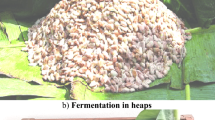Abstract
Tofu samples consisting of ‘Fresh Tofu’, ‘Herb Tofu’, ‘Tofu Paste’, ‘Fried Tofu’, ‘Tofu Burger’, ‘Smoked Tofu’ and different types of herbs used for making ‘Herb Tofu’ were analysed for their microbiological load. Tempeh samples consisted of cook water, inoculated beans and fresh tempeh. ‘Fresh Tofu’ and ‘Herb Tofu’ had high bacterial counts (≥105 cfu/g). ‘Tofu Burger’ and ‘Smoked Tofu’ had counts around 104 cfu/g. ‘Tofu Paste’ and ‘Fried Tofu’ had low counts (<102 cfu/g). Cutting board, knife and frequent hand contact with product were the major sources of contamination for tofu. Herbs used for making ‘Herb Tofu’ were highly contaminated (>105 cfu/g). Cook water and cooked beans for tempeh production had lower counts (≤104 cfu/g). Initial count of fresh tempeh was high (about 108 cfu/g). Most products had counts of >106 cfu/g after 7 days of cold storage. The microbiological quality of the product may improve if producers avoid unnecessary contamination during processing.
Similar content being viewed by others
References
Ashenafi M, Busse M (1989) Inhibitory effect ofLactobacillus plantarum onSalmonella infantis, Enterobacter aerogenes andEscherichia coli during tempeh fermentation. J Food Prot 52: 169–172.
Ashenafi M, Busse M (1990) Growth ofBacillus cereus in fermenting tempeh made from various beans and its inhibition byLactobacillus plantarum. J Appl Bacteriol 70: 329–333.
Aulisio CCG, Stanfield JT, Weagant SD, Hill WE (1983) Yersiniosis associated with tofu consumption: serological, biochemical and pathogenicity studies ofYersinia enterocolitica isolates. J Food Prot 46: 226–230.
Gregersen G (1978) Rapid method for distinction of gram negative from gram positive bacteria. Eur J Appl Microbiol 5: 123–127.
Hugh R, Leifson E (1953) The taxonomic significance of fermentative versus oxidative gram negative bacteria. J Bacteriol 66: 24–26.
Kovaks N (1956) Identification ofPseudomonas pyocyanae by the oxidase reaction. Nature 178: 703.
Kovats SK, Doyle MP, Tanaka N (1984) Evaluation of the microbiological safety of tofu. J Food Prot 47: 618–622.
Nolan C, Harris N, Ballard J, Allard J, Kobayashi J (1982) Outbreak ofYersinia enterocolitica Washington State. Morbid Mortal Weekly Rep 31: 562–564.
Nout MJR, Beirnick G, Bonants-van Laarhoven TMG (1987) Growth ofBacillus cereus in soybean tempeh. Int J Food Microbiol 4: 293–302.
Nout MJR, Notermans S, Rombouts FM (1988) Effect of environmental conditions during soyabean fermentation on the growth ofStaphylococcus aureus and production and thermal stability of enterotoxins A and B. Int J Food Microbiol 7: 299–309.
Rehberger TG, Wilson LA, Glatz BA (1984) Microbiological quality of commercial tofu. J Food Prot 47: 177–181.
Samson RA, Van Kooij JA, De Boer E (1987) Microbiological quality of commercial tempeh in the Netherlands. J Food Prot 50: 92–94.
Steinkraus KH, Hwa YB, Van Buren JP, Provvidenti MI, Hand DB (1960) Studies on tempeh — an Indonesian fermented soybean food. Food Res 25: 777–788.
Szabo RA, Jarvis GA, Weiss KF, Raymann K, Lachapelle G, Jean A (1989) Microbiological quality of tofu and related products in Canada. J Food Prot 52: 727–730.
Tanaka S, Kovalis SK, Guggesberg JA, Meske LH, Doyle MP (1985) Evaluation of the microbiological safety of tempeh made from unacidified soybeans. J Food Prot 48: 438–441.
Wang HL, Hesseltine CW (1982) Coagulation conditions in tofu processing. Process Biochem 17: 7–12.
Wang HL, Mustakas GC, Wolf WJ, Wang LC, Hesseltine CW, Bagley EB (1979) Soybeans as Human Food — Unprocessed and Simply Processed. U.S. Department of Agriculture Science and Education Administration, Washington, D.C., 54pp.
Author information
Authors and Affiliations
Rights and permissions
About this article
Cite this article
Ashenafi, M. Microbiological evaluation of tofu and tempeh during processing and storage. Plant Food Hum Nutr 45, 183–189 (1994). https://doi.org/10.1007/BF01088476
Received:
Accepted:
Issue Date:
DOI: https://doi.org/10.1007/BF01088476




